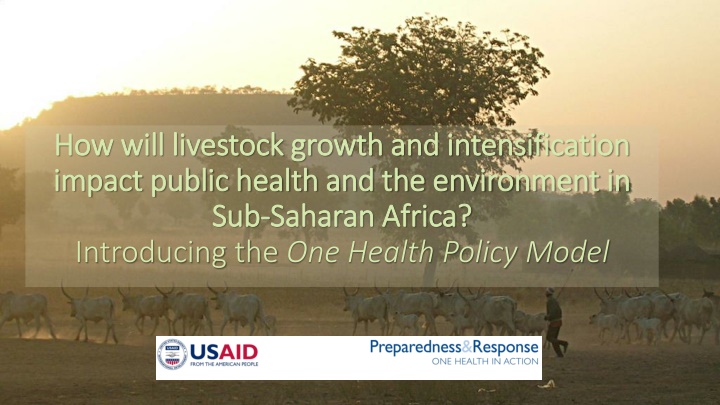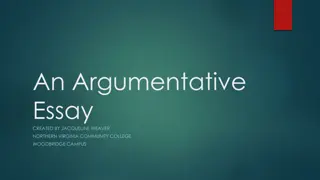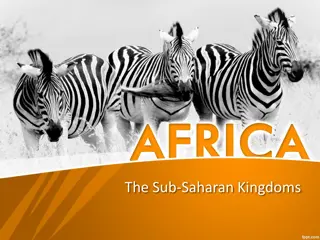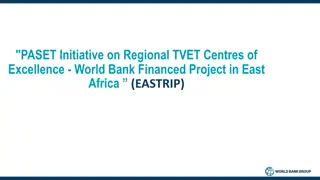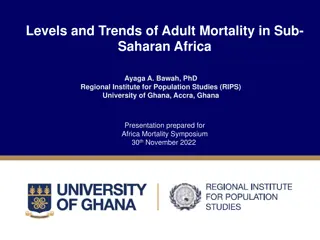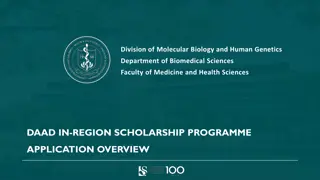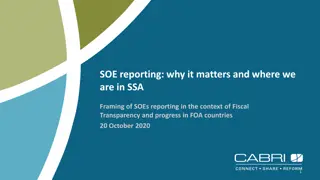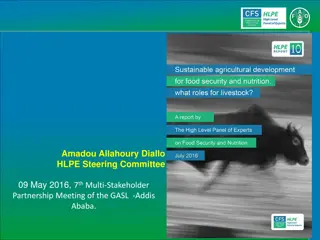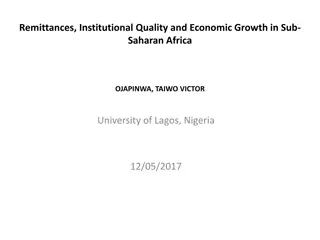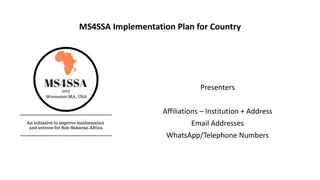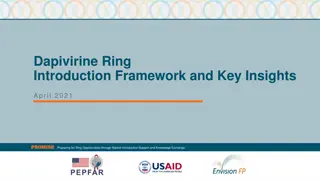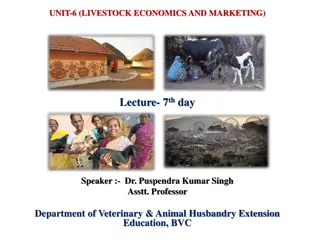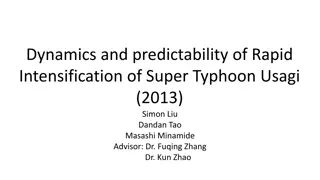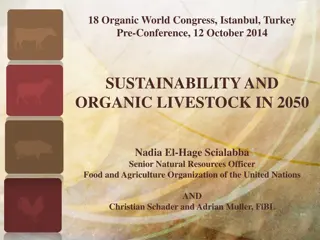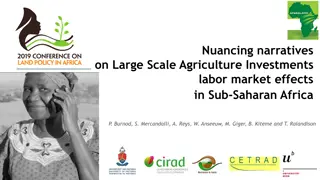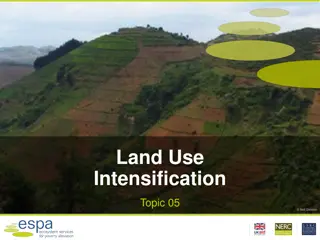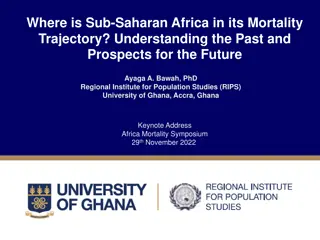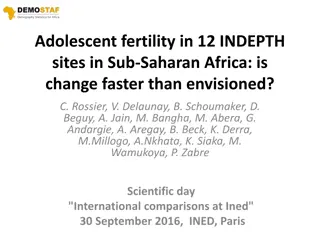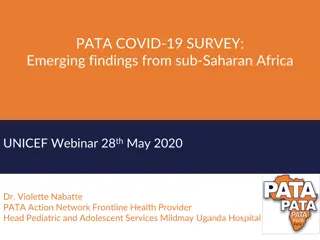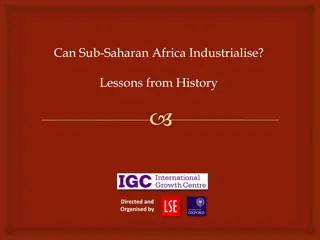Livestock Growth and Intensification Impact in Sub-Saharan Africa
Livestock growth and intensification in Sub-Saharan Africa pose significant challenges to public health and the environment, leading to increased zoonotic diseases, pressure on water sources, and greenhouse gas emissions. The One Health Policy Model offers solutions by understanding threats, policy modeling, and organizing a multi-sector response. Various types of models can aid decision-makers in balancing the need for livestock production with environmental and health protection. Key questions include the burden of zoonotic diseases and the economic impacts of livestock intensification.
Download Presentation

Please find below an Image/Link to download the presentation.
The content on the website is provided AS IS for your information and personal use only. It may not be sold, licensed, or shared on other websites without obtaining consent from the author.If you encounter any issues during the download, it is possible that the publisher has removed the file from their server.
You are allowed to download the files provided on this website for personal or commercial use, subject to the condition that they are used lawfully. All files are the property of their respective owners.
The content on the website is provided AS IS for your information and personal use only. It may not be sold, licensed, or shared on other websites without obtaining consent from the author.
E N D
Presentation Transcript
How will livestock growth and intensification How will livestock growth and intensification impact public health and the environment in impact public health and the environment in Sub Sub- -Saharan Africa? Saharan Africa? Introducing the One Health Policy Model
The livestock The livestock- -zoonosis paradigm zoonosis paradigm Impact on public health Increased Zoonotic Diseases Growth in Livestock Zoonotic-diseases.org Zoonotic-diseases.org Increased pressure on water sources Africantechnolgyfoundation.org Impact on Livelihoods Shuttlestock.com Growth in Population Kality.com More greenhouse gas emissions Livescience.com Blogs.cfr.org
How can a country address these challenges? How can a country address these challenges? Understand the nature and size of the threats Know what the policy and program options are Organize a multi-sector response Policy modeling Policy modeling can help support strategies that balance the need for increased livestock as a source of food and export revenues with the need to protect public health and the environment.
Types of models Types of models Research models: answer specific questions Predictive models: predict future events or indicators Policy models: assist decision-makers in understanding a problem and choosing options
What is the expected burden of zoonotic disease among animals and humans under alternative scenarios? Questions the Questions the One Health One Health Policy Model Policy Model can address can address What are the environmental effects of livestock growth and intensification? How will the zoonotic disease burden change with interventions to control or mitigate the effects of zoonotic diseases? What are the economic impacts of zoonotic disease?
Basic elements of the One Health Policy Model Basic elements of the One Health Policy Model Human population projection Livestock population projection Environmental Impacts Economic Impact Zoonotic disease Public health impact
Basic elements of the One Health Policy Model Basic elements of the One Health Policy Model Human population projection Livestock population projection Environmental Impacts Economic Impact Zoonotic disease Interventions Public health impact
Disease Disease transmission transmission
Intervention Example 1 Example 2 May vary by: Annual or routine testing of herds Food safety improvements, such as pasteurization Quarantine animals with symptoms Food safety improvements, such as pasteurization Herd quarantine and vaccination Production System, Disease, Country Affected Human Populations, Disease, Country Affected Human Populations, Disease, Country Affected Human Populations, Disease, Country Affected Human Populations, Disease, Country Animal Health Interface - Consumers Consumer education Interface - Livestock Keepers Effective waste management Regulate imports of untreated animal products Spillover - Consumers Spillover - Livestock Keepers Vaccinate at-risk populationsHand hygiene Human Amplification Hand hygiene Vaccine Disease, Country Examples of interventions Examples of interventions
Calculation of economic impacts Calculation of economic impacts DALYs Cost of DALY Infected humans Value of statistical life Private out-of- pocket costs Total Cost of Zoonoses Public costs Infected animals
Calculation of economic impacts Calculation of economic impacts DALYs Cost of DALY Infected humans Value of statistical life Private out-of- pocket costs Total Cost of Zoonoses Public costs Price Animal mortality Value of animals lost Infected animals Animals culled Value of foregone animal production Reduced fertility
Dimensions of the One Health Policy Model Dimensions of the One Health Policy Model Animal Species Human populations at risk Zoonotic disease Production systems
Human population growth rate Animal population growth rate Distribution of animals by production system Distribution of humans by type of contact Interventions One Health One Health Policy Model Policy Model inputs and inputs and program program levers levers
One Health Policy One Health Policy Model Model outputs outputs # human cases # of cases in animals # of humans died # of animals died + culled DALYs GHG emissions Healthcare cost of human cases Water footprint Economic loss
Kenya Beef Cattle Application of the model under the FAO/African Sustainable Livestock 2050 Initiative 2015 2050 2050 Animal production systems - Shares Feedlot Semi-Intensive Extensive Pastoralism Extensive Ranching Total Baseline & BAU Canaan 41.0% 24.6% Matatu Kingdom 0.3% 38.0% 56.4% 5.3% 100.0% 3.9% 48.7% 43.4% 3.9% 100.0% 8.2% 26.2% 100.0% Baseline & BAU Animal population growth Canaan Matatu Kingdom Number of Animals 14,309,749 25,268,004 Baseline & BAU 39% 7% 21,464,624 Populations exposed to animals Consumers of animal products Livestock keepers Canaan Matatu Kingdom 49% 6% 37% 7% Total Population 42,961,187 96,000,000 96,000,000
Sample Results: Kenya Beef Cattle - Brucellosis Number of Animals, 2050 Infected Animals, 2050 30,000,000 1,600,000 1,400,000 25,000,000 1,200,000 20,000,000 1,000,000 15,000,000 800,000 600,000 10,000,000 400,000 5,000,000 200,000 0 0 Today BAU Canaan Matatu Kingdom Today BAU Canaan Matatu Kingdom
Sample Results: Kenya Beef Cattle - Brucellosis Human Cases, 2050 Total Cost to Society, 2050 5,000,000 700,000 4,500,000 600,000 4,000,000 500,000 Millions Shillings 3,500,000 400,000 3,000,000 300,000 2,500,000 2,000,000 200,000 1,500,000 100,000 1,000,000 0 500,000 Today BAU Canaan Matatu Kingdom 0 Today BAU Canaan Matatu Kingdom Livestock Industry Cost Human Health Cost
Sample Results: Kenya Beef Cattle Environmental Impacts Water Footprint, 2050 GHG Footprint, 2050 100.00% 30.00% 90.00% 25.00% 80.00% 70.00% 20.00% 60.00% 50.00% 15.00% 40.00% 10.00% 30.00% 20.00% 5.00% 10.00% 0.00% 0.00% Today BAU Canaan Matatu Kingdom Today BAU Canaan Matatu Kingdom
Live Live demonstration demonstration of the model of the model
For further information: For further information: Scott Moreland Scott Moreland scott.moreland@thepalladiumgroup.com scott.moreland@thepalladiumgroup.com
